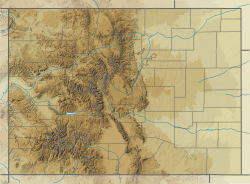| Vermejo Formation | |
|---|---|
| Stratigraphic range: Maastrichtian PreꞒ Ꞓ O S D C P T J K Pg N | |
| Type | Formation |
| Underlies | Raton Formation |
| Overlies | Trinidad Sandstone |
| Thickness | 375 ft (114 m) |
| Lithology | |
| Primary | Sandstone, shale |
| Other | Coal |
| Location | |
| Coordinates | 36°53′N 105°00′W / 36.89°N 105.00°W / 36.89; -105.00 |
| Region | New Mexico Colorado |
| Country | |
| Type section | |
| Named for | Vermejo Park |
| Named by | W.T. Lee |
| Year defined | 1913 |
  | |
The Vermejo Formation is a geologic formation of Upper Cretaceous age. It outcrops in the Raton Basin of northeastern New Mexico and southern Colorado.
Description
The formation consists of a light gray, soft, friable sandstone and shale, which is carbonaceous in part, and may have coal seams or thin coal beds. The Vermejo Formation is about 375 feet (116m) thick at the type locality which is Vermejo Park in Colfax County, New Mexico.
The Vermejo Formation unconformably overlies the Trinidad Sandstone, and unconformably underlies the Raton Formation.
The Rail Canyon sandstone member is a sandstone bed up to 50 feet (15 m) thick that is found 10–50 feet (3.0–15.2 m) above the base of the formation.
Economic geology
The Vermejo Formation is an historically important coal-bearing formation. Mining began in 1870 in the rich Raton coal bed near the base of the Vermejo Formation. The bed contained bituminous coals of coking quality. These were being extensively exploited by 1924 but the beds were largely exhausted by 1965.
The formation has also been exploited for coalbed methane.
History of investigation
The Vermejo Formation was originally named by W. T. Lee in 1913 in the American Journal of Science. In 1917, Lee described the formation more completely.
See also
References
- Cather, Steven M. (2004). "Laramide Orogeny in Central and Northern New Mexico and Southern Colorado". In Mack, Greg H.; Giles, Katherine A. (eds.). The Geology of New Mexico: A Geologic History. New Mexico Geological Society. pp. 203–248.
- ^ Lee, W.T. (1917). "Geology of the Raton Mesa and other regions in Colorado and New Mexico". U.S. Geological Survey Professional Paper. 101: 9–221. Retrieved 4 September 2020.
- Maclachlan, M.E. (1976). "Lexicon of rock-stratigraphic units in Union, Colfax, Mora, and eastern Taos Counties, New Mexico" (PDF). New Mexico Geological Society Field Conference Series. 27: 205–215. Retrieved 4 September 2020.
- ^ Lee, W.T. (1924). "Coal resources of the Raton coal field, Colfax County, New Mexico". U.S. Geological Survey Bulletin. 752. Retrieved 4 September 2020.
- ^ Pillmore, C.L. (1969). "Geology and coal deposits of the Raton coal field,Colfax County, New Mexico". The Mountain Geologist. 6: 125–142. Retrieved 4 September 2020.
- Johnson, Ronald C.; Finn, Thomas M. (June 2001). "Potential for a Basin-Centered Gas Accumulation in the Raton Basin, Colorado and New Mexico" (PDF). U.S. Geological Survey Bulletin. 2184-B. Retrieved 4 September 2020.
- Higley, Debra K. (2007). "Petroleum Systems and Assessment of Undiscovered Oil and Gas in the Raton Basin - Sierra Grande Uplift Province, Colorado and New Mexico". U.S.G.S. Data Series. Data Series. doi:10.3133/ds69N. Retrieved 4 September 2020.